A flight of stairs is a functional element that provides vertical connections. The structure consists of horizontal platforms and marches, in which the number of steps should not exceed eighteen units. Fences, although they are secondary structures, play an important role. It is the railings for the stairs that provide safe movement, provide a point of support for the hands.
Content
- Design features
- Guidelines for handrails and fences
- Height
- Width
- Distances of supports under the railing
- Railing material
- Metal
- Natural wood
- Glass
- Plastic
- Wrought iron railing
- Concrete and stone
- Combined
- How railings and railings match style
- How to make a handrail
- Drafting a project
- Choosing wood
- Making and fixing balusters
- Handrail manufacturing
- Conclusion
Design features
There are many classifications of stairs. By purpose, the following structures can be distinguished: basic, auxiliary (spare, service). By location: outdoor, indoor, intra-apartment. In shape: straight, swivel, curved, combined. They also differ in the material of manufacture, the main bearing components, the presence of a riser, the method of construction, and other characteristics.

Regardless of the configuration of the staircase, if it consists of 3 or more steps, then it must be equipped with guardrails. There are two main types of fences: standard, special-purpose. The first includes typical structures installed in buildings. The second includes supporting elements for children, as well as for citizens with disabilities. The main purpose of the railings:
- preventing a person from falling outside the fence;
- ensuring comfortable movement along the flight of stairs;
- decoration of the interior or exterior of the building.

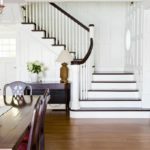



Railing - a low fence installed along the edge of a staircase, balcony, terrace, bridge. It consists of the following components:
- Handrail - the upper horizontal element of the fence, fixed to the wall or balusters, on which the hand rests. It should have a smooth surface without burrs or sharp corners. In shape, there are round, oval, rectangular options.
- Balusters are vertical support posts. They are securely attached to the stairway and serve as a support for the handrail.
- Filler - elements fixed between the support posts. They perform not only a decorative function, but also a protective one.

In turn, depending on the version, it has the following classification:
- classic - represented by straight or curly racks, fixed vertically or obliquely;
- artistic - the space between the supports is filled with decorative components;
- crossbar - horizontal strips are attached to the vertical posts;
- solid - the space between the steps and the handrail is closed with solid panels.





To create stylish, original spiral and other staircases, various types of fences can be combined.

Guidelines for handrails and fences
The design of stairs is carried out at the stage of creating a general project. In multi-storey buildings, this is the main link between rooms, which not only ensures movement, but also must be safe and comfortable. According to SNiP 2.08.01-89 p. 1.17 and SNiP 2.08.02-89 p. 1.91 flights of stairs should have fences with handrails.





In the manufacture of handrails, it is necessary to comply with the existing rules established by regulatory documents:
- GOST 23120-78 "Flight stairs, platforms and steel railings".
- SP 118.13330.2012 p. 6.16 and SNiP 2.01.07-85 p. 3.11 standard values of horizontal loads on handrail handrails should be: 0.3 kN / m for residential buildings, preschool institutions, hospitals, sanatoriums; 0.8 kN / m for other buildings and premises without special requirements; 1.5 kN / m for stands and sports halls.
- GOST 30247.0-94 “Building structures. Fire resistance test methods ".
- SNiP 2.03.11-85 p. 5; SNiP 3.04.03-85 p. 2.1-2.8, 3 "Protection of building structures and structures from corrosion".
- GOST 25772-83 "Enclosures for stairs, balconies and roofs" in p. 1.3 the basic requirements are written down.
- Provision of escape routes. Compulsory compliance with SNiP 2.08.02-89 p. 1.96 and later, for example, SP 118.13330.2012 p. 6.9. These are the minimum widths.

For children and people with disabilities, constructions are used to which special requirements are imposed. They are regulated by the following documents: SNiP 2.08.02-89 p. 1.92, GOST 25772-83 p. 1.3, SNiP 35-01-2001 p. 3.29.





Height
The height of the railing is of great importance when moving up the stairs. However, this parameter, like many others, is regulated by regulatory documents, in particular, according to SNiP 31-01-2003 p. 8.3 The height of the fences for stairs in places of dangerous drops should be at least 1.2 m. You should also pay attention to GOST 25772-83. Based on these and other materials, the following requirements can be distinguished:





For flights of stairs, m:
- internal - 0.9;
- external - 1.2;
- in preschool facilities - 1.2.

For balcony blocks, m:
- buildings less than 28 m - 1;
- more than 28 m - 1.1;
- in preschool facilities - 1.2.
When designing private houses, you should adhere to SP 55.13330.2016, where in p. 8.3 the height of the fences is determined - more than 0.9 m. The rules are advisory in nature, but you should not neglect them, even for the sake of the interior. Their observance will allow you to protect yourself, relatives, friends from unforeseen situations and injuries.




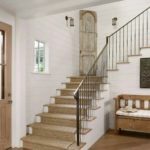
Width
The handrail is an important part of the handrail design, which is held on when moving up or down. It can be rectangular, round, oval. And if the height of the fences, the distance between the balusters is regulated, then the width parameter for this element is not standardized, in fact, it can be anything. The main thing when choosing dimensions is a comfortable girth for the hand. Therefore, the cross-sectional size can fluctuate within 3 - 7 cm.

However, in GOST R 51261-99 in p. 5.1.6 handrails located in residential buildings must be round or rectangular. In the first case, their diameter is at least 3 cm for children, but not more than 5 cm for adults. In the second, a run from 2.5 to 3 cm is allowed.




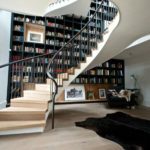
Distances of supports under the railing
Considering the above standards, only for some institutions the distances between the balusters are determined. One of these are preschool organizations, where the clearance between vertical supports should not exceed 0.1 m. public and residential buildings - 0.12 m.In private houses, this value can be anything, but experts recommend making a distance not exceeding 0.5 m in length.

Railing material
Stair railings are made from different raw materials. The choice of the most suitable substance depends on the type of building (private house, public institution or institution), installation location (outdoors, in the garden, indoors), general interior, exterior, personal preferences owner. The main materials used are: metal, wood, plastic, glass, concrete. There are also combined options. Each of these types is characterized by its own characteristics, has advantages and disadvantages.






Metal
For the production of metal profile railings, aluminum, stainless steel, steel, cast iron, brass can be used. The first two options are the most common, so let's dwell on them in more detail:
- Aluminum structures. When choosing this material, you should take into account its softness. Under the influence of heavy loads, it can deform and even break, therefore such fences should not have additional decorative elements. Among the advantages of aluminum are:
- light weight;
- easy installation;
- neutrality to moisture, respectively, resistance to corrosion;
- attractive appearance;
- natural shine;
- low cost.
- Stainless steel. This is a durable raw material that allows you to make a reliable, comfortable fence that can withstand heavy loads. Among the advantages are:
- long service life;
- moisture resistance;
- safety and practicality in use;
- easy care;
- aesthetics, suitable for many modern styles, for example, high-tech, modern, minimalism;
- environmental friendliness and hygiene;
- the ability to combine with glass, wood, plastic.
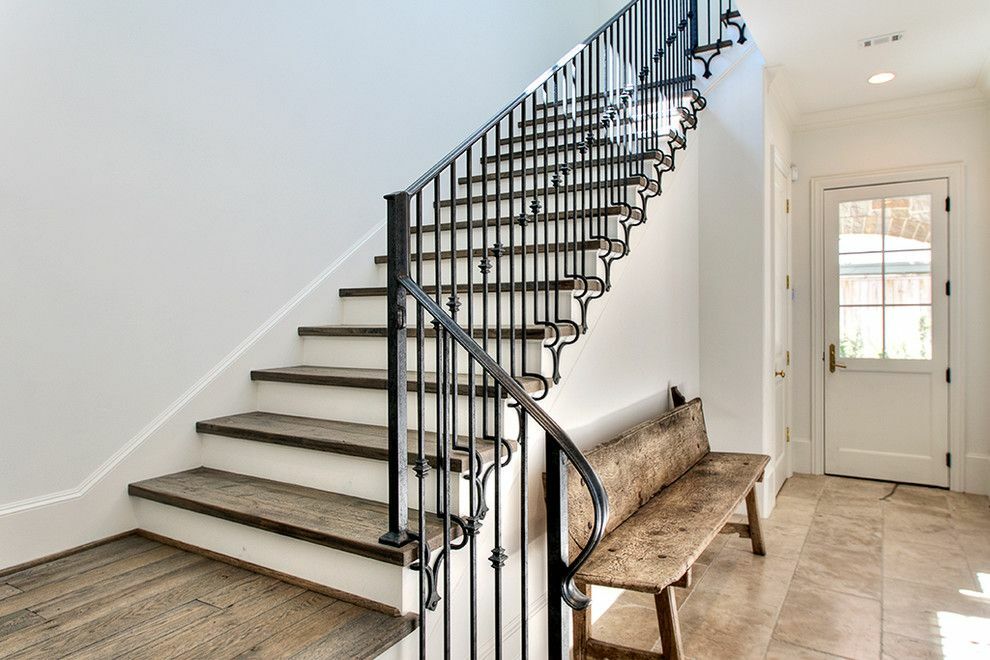
In principle, stainless steel handrails have the same characteristics as aluminum ones. However, they are heavy, cost an order of magnitude more expensive, and over time, numerous scratches and chips appear on their surface. Aluminum is devoid of these drawbacks, but it loses in aesthetic terms.





Natural wood
Wood is a natural material that does not lose its relevance. The staircase structure, partially or completely consisting of wooden elements, will fill the house with warmth and bring comfort to it. This is an ideal option for those who want to give their home naturalness and care about environmental friendliness. For the production of fences, oak, larch, ash, beech, pine are used.
Each breed has its own characteristics. Oak is the most durable lumber. It looks very expensive, its service life is more than 10 years. The choice of one or another type of wood depends on its price, the required quality. Among the main advantages of natural wood are:
- versatility, wood is compatible with almost all interior styles;
- the substance is warm and pleasant to the touch;
- reliability and durability;
- environmental safety;
- attractive appearance;
- the ability to create the most unusual shapes, use carved elements;
- the presence of a natural pattern;
- simple installation activities.

Flaws:
- high cost, especially carved products;
- wooden structures are prone to decay, even the use of special antiseptics and varnishes allows you to solve this problem for a short time;
- low quality wood is not durable; if handled carelessly, chips and cracks may appear on the surface.





Glass
Glass railings look unusual. They are quite rare in comparison with wooden and metal fences. And although at first glance the products may seem insufficiently reliable, they are not. They are made of impact-resistant material that can withstand significant loads. Such structures can be installed even by families with children without fear for their safety.
In the production of fences, tempered glass or triplex is used, which can be transparent, matte, tinted, stained glass, corrugated, with a print, have LED backlighting. The quality of the material guarantees a long service life of the product, moreover, over time, cracks or chips will not appear on its surface. Despite the fact that the substance is self-sufficient, the railings are often supplemented with wooden, metal, chrome-plated, plastic elements.
Advantages:
- attractive, unusual appearance;
- visual increase in space;
- durability;
- complete neutrality to moisture;
- resistance to temperature changes;
- a large selection of different design options;
- easy installation.
Flaws:
- high price;
- difficult care, stains remain on the surface.

Plastic
Structures must withstand significant loads, therefore, hard plastic is used in their manufacture. This material allows you to create railings of almost any shape, which have a wide range of colors. Finished products can be installed both indoors and outdoors. The cost of such fences is not high, but they are not popular. The main advantages include:
- resistance to aggressive media, alkalis, detergents;
- a wide variety of shapes;
- light weight;
- the material does not conduct current;
- warm to the touch;
- does not require additional painting, treatment with impregnations.
Flaws:
- low strength, with a strong impact it breaks, cracks;
- low-quality raw materials are environmentally unsafe, release toxins;
- low frost resistance;
- becomes brittle at temperatures below 15 °;
- fades under direct sunlight.

Wrought iron railing
Forged structures are one of the most attractive metal products. They are able to emphasize the original interior of a country house or apartment. They can be installed not only in private homes, but also in public institutions, for example, in restaurants, hotels, cafes. The cost of the fence directly depends on the total weight of the structure, the number of decorative elements, and the type of decoration.
Another important factor is the type of forging, which can be done hot or cold. The first method of production is more laborious, but it allows you to get original, unique products, the price of which is very high. The elements obtained in the second way are made according to the template, with the help of special devices, they are not distinguished by exclusivity.
Advantages:
- long service life;
- the ability to create a unique design;
- resistance to various influences;
- strength and reliability;
- ergonomics.

Flaws:
- high cost, since manual labor is used;
- long production times;
- the complexity of the installation;
- increased risk of injury due to the presence of sharp parts;
- great weight.





Concrete and stone
Due to their high weight, concrete and stone railings are practically not used indoors, they are intended for outdoor installation. If we talk about natural stone, then such designs are extremely rare. And although marble or granite looks luxurious, their cost is simply prohibitive. In addition, it takes a lot of time to process the material, so in most cases artificial analogs are used.

Concrete fences are easier to manufacture, they are obtained by pouring concrete mixture into molds. They are characterized by durability, tolerate high and low temperatures well, and have a low price. But the material also has its drawbacks: relatively large weight, unattractive appearance, high porosity. Without periodic painting, the fences begin to collapse under the influence of moisture.





Combined
Combined fences are products that combine different materials. Glass, wooden beams, forged elements, etc. act as filling in them. Due to the combination of different substances, the structures have a unique appearance, are compatible with any style, and are suitable for decorating both classic and modern interiors.
For the production of racks, stainless steel is most often used, which goes well with any raw material. The included handrails can be made from hardwood or high quality plastic. Plexiglas or triplex covers the space between steps and handrails. Also, the use of ordinary black metal, decorative elements made of brass, copper or bronze is appropriate here.

How railings and railings match style
In a private house, a staircase serves not only as an interior item that allows you to move between floors, but is also a significant decorative element. Safety staircases can be represented by balusters, railings, posts, handrails and other structures installed along the wall. In order for the structure to harmoniously fit into the overall environment, it is important to choose the right type of railings and materials for their manufacture. They can be performed in the following stylistic directions:
- Classic. Solid wrought iron railings with wooden handrails will do. It is possible to use any natural materials and their combinations. The main thing is that they emphasize the richness of the interior.
- Loft. The staircase and railings should be consistent with the old factories' furnishings concept. Racks and handrails are often made of metal pipes or profiles, trying to emphasize the strength of the span. They are covered with paint in accordance with the style, the decor is practically not used.
- Modern. Railings should be laconic. Only geometric lines are allowed in the decoration. Their shape will be the main decoration. Forged elements with intertwining patterns look good. In modern Art Nouveau, glass inserts are possible.
- High tech. Protective fences are made of plastic, glass, metal. The peculiarity of the style is the display of all connecting elements, supporting structures and fasteners.
- Provence. In interiors close to everyday life and nature, the railings are made as light and elegant as possible. If a tree is chosen, it is better to use its light species. An artificial patina will create a unique effect of antiquity.






How to make a handrail
Stair railings can be made from a wide variety of materials. For small two-story houses, wooden structures are more often used. They will include the following details - handrails, balusters, support posts, decorative elements in the form of carved inserts. Do-it-yourself handrail manufacturing should take place according to a pre-planned scheme.

Drafting a project
It is very easy to make a modern handrail for a simple type of staircase. First of all, you need to draw up a detailed drawing. It should reflect the height of the structure, the number, width, length of each element. At the same stage, the configuration of the elements is determined. They can be forged, monolithic, in the form of a bowstring, to be a continuation of the main crossbeams.
The width of the handrails is selected individually based on personal preference. The recommended parameter is 100 mm. The average height of the parts is 900 mm. A deviation from the average parameters is possible, which is influenced by the method of fastening the elements.

Choosing wood
According to building safety standards, stair railings for any project must freely withstand a load of 100 kg. Therefore, it is very important to choose a durable material for the manufacture of elements and securely fasten. For railings, hard hardwoods are suitable, for example, oak, ash, beech. So that the railings are not deformed later, the moisture content of the workpieces should not exceed 18%.
If you decide to use a budget soft tree, you should take into account its properties at the design stage. Such material will shrink and wear out quickly. If the railings are going to be created with your own hands, you need to think in advance about the possibility of making curly products. The tree should be easy to work with.

Making and fixing balusters
Balusters are one of the main parts of the structure. Strong identical racks are fixed on the winder steps at an equal distance from each other. They are made on a lathe or by hand, with the right tool and woodworking skills. Fastening to the curbstone and handrail can be done in several ways:
- On the bolts. A hole of a suitable size is drilled into the steps, a baluster is applied and a fastener is screwed in from below.
- On chopiki. Wooden blanks are inserted into pre-drilled holes, pre-treated with wood glue. If the staircase is mounted on the street and there are no strict requirements for its appearance, stainless steel corners are used as additional fixation.
- Through the bar. This type of mount is suitable for flat balusters. They are attached through the bar directly to the step. This will make the whole structure very strong. Installation is carried out using self-tapping screws and a screwdriver.





Handrail manufacturing
Such elements can be made from a solid board or several blanks can be joined. To increase the rigidity of the structure, it is necessary to adhere to certain rules during installation. For the manufacture of handrails, a bar with a cross section of at least 60 mm is suitable. It must be processed - the lower part can have any shape, and the upper one should be rounded.
Wide railing for stairs in a classic style is made from several component parts. You will need to make a center bar and side rails. Then all the parts are glued together and squeezed with clamps. Shape the resulting box using a planer.



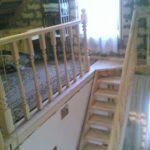
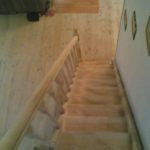


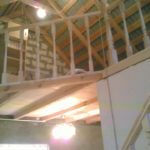

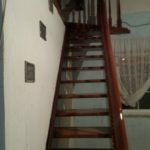

Conclusion
Ladders have long played the role of a beautiful decorative element in addition to their practical function. In the interior of the house, their design is of great importance. Their design is matched to the furniture, and the color scheme to the overall palette of finishes, guided by the photo beforehand. Correctly selected railings will become a source of pride for the owners, emphasize their design talents.
